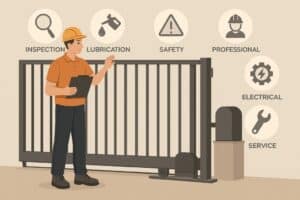Best Practices for Automatic Gate Repair and Maintenance
Key Takeaways
- Regular inspections help identify wear and tear early.
- Proper lubrication reduces friction and prevents rust.
- Keeping the tracks clean ensures smooth gate operation.
- Testing safety features regularly prevents accidents.
- Regular professional maintenance checks can help extend the gate’s lifespan.
Automatic gates are an investment in both security and convenience—but to ensure they operate efficiently and reliably, regular upkeep is a must. From sensors that prevent accidents to motors that enable seamless entry, the need for consistent maintenance cannot be overstated. Failing to provide such care can lead to malfunctions, expensive repairs, and potential safety hazards. For reliable automated gate repair, focusing on a few fundamental maintenance steps will help keep your gate performing optimally year-round.
Understanding how to care for your automatic gate properly can prevent unexpected breakdowns that compromise your property’s safety. Beyond the occasional visual check, implementing a maintenance routine will detect minor problems before they escalate. By learning and applying essential practices, you not only extend the lifespan of your gate system but also help it withstand wear and tear caused by outdoor elements.
Regular Inspection
Scheduling routine visual inspections is the foundation of effective gate maintenance. Begin by examining components such as hinges, bolts, and welds on wrought iron or swing gates for visible rust or corrosion. Pay particular attention to signs of fatigue or loose fastenings, which can be an early warning of more serious damage. If these issues are caught early, repair costs and structural failures can often be avoided.
Another critical step during inspection is to check the gate’s movement for any irregular sounds or resistance, ensuring all hardware is tight and operational. If your gate is automatic, ensure the drive arms and motor mechanisms appear free from blockage or strain.
Lubricate Moving Parts
Consistent lubrication is critical to minimizing friction between moving parts. Rollers, hinges, bearings, and the gate’s drive motor are especially prone to wear if neglected. Apply a silicone-based grease or oil to these moving parts at least twice a year, depending on local weather conditions and frequency of use. This practice reduces squeaks, grinding, and wear—and keeps corrosion at bay, prolonging the lifespan of these crucial elements. For guidance on which lubricant to use or how often to apply it, refer to your manufacturer’s owner manual or consult a professional.
Clean the Gate Tracks
Sliding gates depend on clean, unobstructed tracks to function correctly. Dirt, gravel, leaves, and even small twigs can easily become wedged and obstruct the mechanism, leading to increased motor strain and unnecessary wear and tear. Regular sweeping, followed by a wipe-down using water or a mild, soapy solution, can prevent buildup and keep the track free from blockages. If you notice sticky residue or stubborn dirt, specialized track cleaning solutions may be helpful for a more thorough clean.
Test Safety Features
Modern automatic gates typically feature vital safety measures, such as photoelectric sensors, auto-stop mechanisms, and reverse functions. These components prevent unintended injuries or property damage but are only effective if tested regularly. To check the sensors, place an object between them as the gate is closing. If everything is working correctly, the gate should stop and reverse direction immediately. Making these functional checks part of your monthly routine protects loved ones and visitors, reduces liability, and signals when professional attention is required if safety features malfunction.
Check Electrical Components
Since automatic gates are electrically powered, regular checks of the motor, wiring, and control panels are essential. Look for signs like frayed wires, corrosion, or inconsistent operation. Protect the motor from rain and ensure proper ventilation to prevent overheating. If you suspect electrical problems, don’t attempt repairs yourself—contact a certified technician for diagnostics and repairs.
Schedule Professional Maintenance
DIY tasks can be helpful, but certain repairs and diagnostics should only be handled by professionals. An annual or biannual service is recommended, especially for complex automatic systems. Technicians can identify hidden issues, calibrate sensors, realign gates, and service motors or control panels to ensure optimal performance. Professional maintenance offers peace of mind and documentation, which is useful when selling or making warranty claims. Regular servicing might also be necessary for insurance or warranty validity.
Conclusion
Taking a proactive and systematic approach to automatic gate repair and maintenance keeps your property secure, enhances its functionality, and helps you avoid unexpected expenses. With periodic inspections, prompt lubrication, clean tracks, and routine safety checks, you can rely on your automatic gate for seamless operation and peace of mind—year after year.


